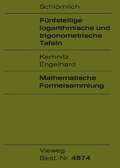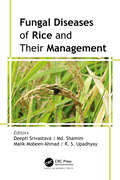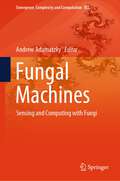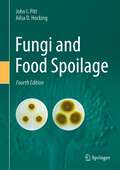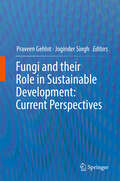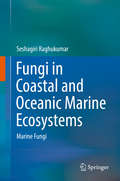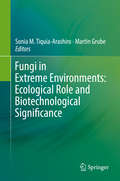- Table View
- List View
Fünfstellige logarithmische und trigonometrische Tafeln
by Oskar Schlömilch Friedrich Kemnitz Rainer EngelhardFünfstellige Tabellen zu den Elliptischen Funktionen / Five Place Tables of Elliptical Functions: Dargestellt Mittels des Jacobischen Parameters q / Based on Jacobi’s Parameter q
by Max Schuler Hans GebeleinFungal Biopolymers and Biocomposites: Prospects and Avenues
by Sunil K. Deshmukh Mukund V. Deshpande Kandikere R. SridharThe book covers an overview of fungal polymers, fungal mycelial biomass, and their applications besides providing a detailed account of various opportunities. This book also includes information on developments in mycotechnology related to fashion, furnishing, construction, packaging, mycelial-based bricks, construction binder, cementing materials, and so on. Other aspects include the value of chitin, chitosan, hydrophobins, lignocellulosic composites, oil recovery, biosurfactants and bioemulsifiers, nanofibers from pullulan, exopolymeric substances, bioresins, and biocomposites. Additional topics covered in the book include self-healing fungal concrete (which could help to build repairs) and recipe to inhibit fruit body formation, for living fungal biomaterial manufacture. There is no comprehensive book other than – some reviews, which addressed very brief historical developments and preliminary aspects of fungal biopolymers. Written by experts in their field from countries like Australia, India, USA, Germany, Turkey, Philippines, Oman, Belgium, Italy, Egypt, Brazil, and the United Kingdom, the chapters discuss at length applications of filamentous fungi in sustainable industrial pursuits and industrial developments with environmental safety. This book will be useful for students, teachers, researchers, and scientists in botany, microbiology, life sciences, biotechnology, agriculture and, industries that extensively use fungi for the production of value-added products.
Fungal Cellulolytic Enzymes: Microbial Production and Application
by Xu Fang Yinbo QuThe book provides an overview of the current knowledge on cellulolytic enzymes and their applications. It summarizes the mechanisms of synthesis and hydrolysis of cellulolytic enzymes, industrial fungal strains, genetic engineering of fungal strains and application of cellulolytic enzymes. This book will be a useful reference for researchers and bioengineering experts engaged in lignocelluloses biodegradation, biomass utilization, enzyme production and fungal molecular biology.
Fungal Diseases of Rice and Their Management
by Deepti Srivastava Md. Shamim Malik Mobeen Ahmad R. S. UpadhyayRice is a widely consumed crop around the world that has tremendous importance and is cultivated almost everywhere except Antarctica. However, various biotic and abiotic stresses have a negative effect on rice cultivation, seriously reducing its yield. This volume examines the bacterial and fungal pathogens that cause rice diseases and explores how to manage these diseases. It covers the economic and environmental impact of rice fungal diseases on global food security and proceeds to delve into diagnostic methods for rice fungal pathogen detection and discusses current strategic and applied biotechnological methods for the effective management of rice fungal diseases.
Fungal Diseases of Rice and Their Management
Rice is a widely consumed crop around the world that has tremendous importance and is cultivated almost everywhere except Antarctica. However, various biotic and abiotic stresses have a negative effect on rice cultivation, seriously reducing its yield. This volume examines the bacterial and fungal pathogens that cause rice diseases and explores how to manage these diseases. It covers the economic and environmental impact of rice fungal diseases on global food security and proceeds to delve into diagnostic methods for rice fungal pathogen detection and discusses current strategic and applied biotechnological methods for the effective management of rice fungal diseases.
Fungal Machines: Sensing and Computing with Fungi (Emergence, Complexity and Computation #47)
by Andrew AdamatzkyThis unique book explores fungi as sensors, electronic devices, and potential future computers, offering eco-friendly alternatives to traditional electronics. Fungi are ancient, widely distributed organisms ranging from microscopic single cells to massive mycelium spanning hectares. They possess senses similar to humans, detecting light, chemicals, gases, gravity, and electric fields. It covers fungal electrical activity, sensors, electronics, computing prototypes, and fungal language. Authored by leading experts from diverse fields, the book is accessible to readers of all backgrounds, from high-schoolers to professors. It reveals the remarkable potential of fungal machines while minimizing environmental impact.
Fungal Nanobionics: Principles and Applications
by Ram Prasad Vivek Kumar Manoj Kumar Shanquan WangFungal nanobionics has great prospects for developing new products with industrial, agriculture, medicine and consumer applications in a wide range of sectors. The fields of chemical engineering, agri-food, biochemical, pharmaceuticals, diagnostics and medical device development all employ fungal products, with fungal nanomaterials currently used in a wide range of applications, ranging from drug development to food industry and agricultural sector. The fungal agents emerge as an environmentally friendly, clean, non‐toxic agent for the biogenic metal nanoparticles and employs both intracellular and extracellular methods. The simplicity of scaling up and downstream processing and the presence of fungal mycelia affording an increased surface area provide key advantages. In addition, the larger spectrum of synthesized nanoparticle morphologies and the substantially faster biosynthesis rate in cell-free filtrate (due to the higher amount of proteins secreted in fungi) make this a particularly enticing route. Understanding the diversity of fungi in assorted ecosystems, as well as their interactions with other microorganisms, animals and plants, is essential to underpin real and innovative technological developments and the applications of metal nanoparticles in many disciplines including agriculture, catalysis, and biomedical biosensors. Importantly, biogenic fungal nanoparticles show significant synergistic characteristics when combined with antibiotics and fungicides to offer substantially greater resistance to microbial growth and applications in nanomedicine ranging from topical ointments and bandages for wound healing to coated stents.
Fungal Nanotechnology: Applications in Agriculture, Industry, and Medicine (Fungal Biology)
by Ram PrasadFungal nanotechnology has great prospects for developing new products with industrial, agricultural, medicinal, and consumer applications in a wide range of sectors. The fields of chemical engineering, agri-food, biochemistry, pharmaceuticals, diagnostics, and medical device development all employ fungal products, with fungal nanomaterials currently used in applications ranging from drug development to the food industry and agricultural biotechnology. Fungal agents are an environmentally friendly, clean, non‐toxic agent for the synthesis of metal nanoparticles and employ both intracellular and extracellular methods. The simplicity of scaling up and downstream processing and the presence of fungal mycelia which afford an increased surface area provide key advantages. In addition, the large spectrum of synthesized nanoparticle morphologies and the substantially faster biosynthesis rate in cell-free filtrate (due to the higher amount of proteins secreted in fungi) make this a particularly enticing route. Understanding the diversity of fungi in assorted ecosystems, as well as their interactions with other microorganisms, animals, and plants, underpins real and innovative technological developments and the applications of metal nanoparticles in many disciplines including agriculture, catalysis, and biomedical biosensors. Importantly, biogenic fungal nanoparticles show significant synergistic characteristics when combined with antibiotics and fungicides to offer substantially greater resistance to microbial growth and applications in nanomedicine ranging from topical ointments and bandages for wound healing to coated stents.
Fungal Pathogenesis in Plants and Crops: Molecular Biology and Host Defense Mechanisms, Second Edition
by P. VidhyasekaranDramatic progress in molecular biology and genetic engineering has recently produced an unparalleled wealth of information on the mechanisms of plant and pathogen interactions at the cellular and molecular levels. Completely revised and expanded, Fungal Pathogenesis in Plants and Crops: Molecular Biology and Host Defense Mechanisms, Second Edition
Fungal Plant Pathogens: Applied Techniques
by Kinda Alraiss Rachel Barker Victoria Barton Lucy Carson-Taylor David Cooke Ashleigh Elliot David Galsworthy Steve Hendry Anthony Kermode Paul Kirk Michael Long Aiga Ozolina Ana Pérez-Sierra Belinda Phillipson Matthew J Ryan David Smith Christopher Thornton Jenny Tomlinson Joan WebberThis substantially updated edition now in full colour provides key techniques used when working with fungal and fungal-like plant pathogens. As a practical manual it also deals with disease recognition, detection and identification of fungi, plus methods to characterise and curate fungi and handle them under quarantine and quality assurance systems. Furthermore, this new edition includes significant updates with respect to: - Greater awareness and concern internationally about plant health and biosecurity. - Molecular biology - next generation sequencing and in-field detection. - Improved opportunities for surveillance and detection in diverse substrates. - Changes in taxonomy and reference to current fungal plant pathogens. - New chapters on tree health, and public awareness, outreach and communications. Fungal Plant Pathogens: Applied Techniques, 2nd edition provides a valuable guide to investigating fungal plant diseases and interpreting laboratory findings for postgraduate and advanced undergraduate students, extension plant pathologists, consultants and advisers in agriculture, forestry and horticulture, and the food supply chain.
Fungi: Applications and Management Strategies (Progress in Mycological Research #3)
by S. K. Deshmukh J. K. Misra J. P. Tewari Tamás PappThe book deals with the application of fungi and the strategic management of some plant pathogens. It covers fungal bioactive metabolites, with emphasis on those secondary metabolites that are produced by various endophytes, their pharmaceutical and agricultural uses, regulation of the metabolites, mycotoxins, nutritional value of mushrooms, prospecting of thermophilic and wood-rotting fungi, and fungi as myconano factories. Strategies for the management of some plant pathogenic fungi of rice and soybean have also been dealt with. Updated information for all these aspects has been presented and discussed in different chapters.
Fungi: Applications and Management Strategies (Progress in Mycological Research)
by Sunil K. Deshmukh J. K. Misra Jalpa P. Tewari Tamas PappThe book deals with the application of fungi and the strategic management of some plant pathogens. It covers fungal bioactive metabolites, with emphasis on those secondary metabolites that are produced by various endophytes, their pharmaceutical and agricultural uses, regulation of the metabolites, mycotoxins, nutritional value of mushrooms, prospecting of thermophilic and wood-rotting fungi, and fungi as myconano factories. Strategies for the management of some plant pathogenic fungi of rice and soybean have also been dealt with. Updated information for all these aspects has been presented and discussed in different chapters.
Fungi and Food Spoilage
by John I. Pitt A.D. HockingThis book is designed as a laboratory guide for the food microbiologist, to assist in the isolation and identification of common food-borne fungi. We emphasise the fungi which cause food spoilage, but also devote space to the fungi commonly encountered in foods at harvest, and in the food factory. As far as possible, we have kept the text simple, although the need for clarity in the descriptions has necessitated the use of some specialised mycological terms. The identification keys have been designed for use by microbiologists with little or no prior knowledge of mycology. For identification to genus level, they are based primarily on the cultural and physiological characteristics of fungi grown under a standardised set of conditions. The microscopic features of the various fungi become more important when identifying isolates at the species level. Nearly all of the species treated have been illustrated with colony photographs, together with photomicrographs or line drawings. The photomicrographs were taken using a Zeiss WL microscope fitted with Nomarski interference contrast optics. We are indebted to Mr W. Rushton and Ms L. Burton, who printed the many hundreds of photographs used to make up the figures in this book. We also wish to express out appreciation to Dr D.L. Hawksworth, Dr A.H.S.
Fungi and Food Spoilage
by John I. Pitt Ailsa D. HockingIn contrast to the second edition, the third edition of ‘‘Fungi and Food Spoilage’’ is evolutionary rather than revolutionary. The second edition was intended to cover almost all of the species likely to be encountered in mainstream food supplies, and only a few additional species have been included in this new edition. The third edition represents primarily an updating – of taxonomy, physiology, mycotoxin production and ecology. Changes in taxonomy reflect the impact that molecular methods have had on our understanding of classification but, it must be said, have not radically altered the overall picture. The improvements in the understanding of the physiology of food spoilage fungi have been relatively small, reflecting perhaps the lack of emphasis on physiology in modern mic- biological science. Much remains to be understood about the specificity of particular fungi for particular substrates, of the influence of water activity on the growth of many of the species treated, and even on such basic parameters as cardinal temperatures for growth and the influence of pH and preservatives. Since 1997, a great deal has been learnt about the specificity of mycotoxin production and in which commodities and products-specific mycotoxins are likely to occur. Changes in our understanding of the ecology of the included species are also in most cases evolutionary. A great number of papers have been published on the ecology of foodborne fungi in the past few years, but with few exceptions the basic ecology of the included species remains.
Fungi and Food Spoilage
by John I. Pitt Ailsa D. HockingThe first three editions of Fungi and Food Spoilage established, then consolidated, a reputation as the leading book on foodborne fungi. It details media and methods for isolation and identification, descriptions of species, and information on their physiology, ecology and mycotoxin formation. It is an invaluable reference for food microbiologists investigating fungal food spoilage problems, both in field crops and processed foods, and the likelihood of mycotoxin production in either.The Fourth Edition incorporates major differences from the Third: multiple changes in nomenclature due to changes in the International Code of Nomenclature for algae, fungi and plants; many taxonomic changes due to improvements in, and more widespread application of, molecular methods in taxonomy; the introduction of colour colony photographs where appropriate; and a new chapter on mycotoxins.The introductory chapters of the book deal with the ecology of food spoilage, and provide an overview of how food processing, packaging and storage parameters influence fungal growth. A subsequent chapter overviews the fundamentals of naming and classifying fungi. Morphological methods and media suitable for low cost and effective isolation, enumeration and identification of foodborne fungi are provided, together with many more specialised media and techniques. The major part of the book provides keys, descriptions and illustrations of all yeasts and filamentous fungi commonly encountered in foods. Other known characteristics of the species, including physiology and ecology are included. Chapters on the types and species of fungi likely to be found in fresh, harvested and variously processed foods are followed by a new chapter on mycotoxins, both major and minor, their sources, both fungal and food, and their implications for human health.The broad and practical nature of the coverage will appeal to microbiologists, mycologists and biotechnologists in the food industry, as well scientists in academic, research and public health institutions.Drs Pitt and Hocking worked for CSIRO Food for more than 100 years combined. Both are now retired from CSIRO: Dr Pitt continues to work part time with Microbial Screening Technologies, a biodiscovery company.
Fungi and Lignocellulosic Biomass
by Christian P. KubicekHarnessing fungi’s enzymatic ability to break down lignocellulolytic biomass to produce ethanol more efficiently and cost-effectively has become a significant research and industrial interest. Fungi and Lignocellulosic Biomass provides readers with a broad range of information on the uses and untapped potential of fungi in the production of bio-based fuels. With information on the molecular biological and genomic aspects of fungal degradation of plant cell walls to the industrial production and application of key fungal enzymes, chapters in the book cover topics such as enzymology of cellulose, hemicelluloses, and lignin degradation. Edited by a leading researcher in the field, Fungi and Lignocellulosic Biomass will be a valuable tool in advancing the development and production of biofuels and a comprehensive resource for fungal biologists, enzymologists, protein chemists, biofuels chemical engineers, and other research and industry professionals in the field of biomass research.
Fungi and Lignocellulosic Biomass
by Christian P. KubicekHarnessing fungi’s enzymatic ability to break down lignocellulolytic biomass to produce ethanol more efficiently and cost-effectively has become a significant research and industrial interest. Fungi and Lignocellulosic Biomass provides readers with a broad range of information on the uses and untapped potential of fungi in the production of bio-based fuels. With information on the molecular biological and genomic aspects of fungal degradation of plant cell walls to the industrial production and application of key fungal enzymes, chapters in the book cover topics such as enzymology of cellulose, hemicelluloses, and lignin degradation. Edited by a leading researcher in the field, Fungi and Lignocellulosic Biomass will be a valuable tool in advancing the development and production of biofuels and a comprehensive resource for fungal biologists, enzymologists, protein chemists, biofuels chemical engineers, and other research and industry professionals in the field of biomass research.
Fungi and their Role in Sustainable Development: Current Perspectives
by Praveen Gehlot Joginder SinghThis book illustrates the multiple roles of fungi in everyday life. Fungi are the large group of organisms with tremendous diversity and economic importance. Their ability to produce commercially efficient useful products makes them the vulnerable sustainable tool for the future generation. This book describes a systems approach and provides a means to share the latest developments and advances about the benefits of fungi including their wide application, traditional uses, modern practices, along with designing of strategies to harness their potential. The chapters are organized with data, providing information related to different sustainable aspects of fungi in agriculture, its cultivation and conservation strategies, industrial and environmental utilization, advanced bioconversion technologies and modern biotechnological interventions. Updated information and current opinion related to its application for sustainable agriculture, environment, and industries as futuristic tools have been presented and discussed in different chapters. The book also elucidates a comprehensive yet a representative description of the challenges associated with the sustained application of fungi to achieve the goals of sustainability.
Fungi as Bioremediators (Soil Biology #32)
by Ebrahim Mohammadi Goltapeh, Younes Rezaee Danesh and Ajit VarmaBiological remediation methods have been successfully used to treat polluted soils. While bacteria have produced good results in bioremediation for quite some time now, the use of fungi to decontaminate soils has only recently been established. This volume of Soil Biology discusses the potentials of filamentous fungi in bioremediation. Fungi suitable for degradation, as well as genetically modified organisms, their biochemistry, enzymology, and practical applications are described. Chapters include topics such as pesticide removal, fungal wood decay processes, remediation of soils contaminated with heavy and radioactive metals, of paper and cardboard industrial wastes, and of petroleum pollutants.
Fungi in Coastal and Oceanic Marine Ecosystems: Marine Fungi
by Seshagiri RaghukumarThis book offers an ecosystem-oriented overview of the diversity, ecological role, and biotechnological applications of marine fungi as well as an in-depth introduction to the marine environment, fungal classification, and ecological principles. It also presents the latest research findings on coastal marine and oceanic ecosystems, such as mangrove, seagrass, salt marsh, algal, coral reef and benthic ecosystems. Focusing on the diversity of fungi as well as their role as symbionts, parasites and saprotrophs, the book also discusses the physiology and biotechnological applications of fungi and highlights topics of future interest. Intended for students and researchers in marine biology and microbiology, it includes detailed descriptions, illustrations, figures, tables, and exhaustive literature citations. A detailed chapter on methods used to study marine fungi, their classification and ecological principles is of particular interest to newcomers in the field.
Fungi in Extreme Environments: Ecological Role and Biotechnological Significance
by Sonia M. Tiquia–Arashiro Martin GrubeOver the last decades, scientists have been intrigued by the fascinating organisms that inhabit extreme environments. These organisms, known as extremophiles, thrive in habitats which for other terrestrial life-forms are intolerably hostile or even lethal. Based on such technological advances, the study of extremophiles has provided, over the last few years, ground-breaking discoveries that challenge the paradigms of modern biology. In the new bioeconomy, fungi in general, play a very important role in addressing major global challenges, being instrumental for improved resource efficiency, making renewable substitutes for products from fossil resources, upgrading waste streams to valuable food and feed ingredients, counteracting life-style diseases and antibiotic resistance through strengthening the gut biota, making crop plants more robust to survive climate change conditions, and functioning as host organisms for production of new biological drugs. This range of new uses of fungi all stand on the shoulders of the efforts of mycologists over generations. The book is organized in five parts: (I) Biodiversity, Ecology, Genetics and Physiology of Extremophilic Fungi, (II) Biosynthesis of Novel Biomolecules and Extremozymes (III) Bioenergy and Biofuel synthesis, and (IV) Wastewater and biosolids treatment, and (V) Bioremediation.
Fungi in Fuel Biotechnology (Fungal Biology)
by Gholamreza Salehi Jouzani Meisam Tabatabaei Mortaza AghbashloDue to the huge quantity and diverse nature of their metabolic pathways, fungi have great potential to be used for the production of different biofuels such as bioethanol, biobutanol, and biodiesel. This book presents recent advances, as well as challenges and promises, of fungal applications in biofuel production, subsequently discussing plant pathogenic fungi for bioethanol and biodiesel production, including their mechanisms of action. Additionally, this book reviews biofuel production using plant endophytic fungi, wood-rotting fungi, fungal biocontrol agents, and gut fungi, and it investigates highly efficient fungi for biofuel production and process design in fungal-based biofuel production systems. Finally, life cycle assessment of fungal-based biofuel production systems are discussed in this volume.
Fungi of Antarctica: Diversity, Ecology and Biotechnological Applications
by Luiz Henrique RosaThis book focuses on the fungi found in one of the most pristine regions on Earth: Antarctica. It discusses the fungal occurrence in all substrates of the region, including soil, seawater, lake and marine sediments, rocks, ice, and snow. It also addresses the impact of climate changes on these organisms, the genomic techniques developed to study them, and how a number of compounds, such as antibiotics and enzymes, produced by the Antarctic fungi can be used in medicine, agriculture and the chemical industry.
